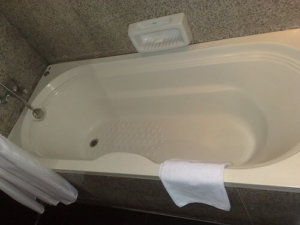Learn About Your Choices in Bathtub Materials
When selecting a bathtub, you might feel overwhelmed with all the material options available. Before choosing the material, make a list of what’s important to you, such as cost, texture, and weight. Each type of material has its benefits and disadvantages, and the option you select depends on your style. Use this guide to review your options before purchasing a bathtub.
Acrylic

Image via Flickr by Indonesia Matters
Acrylic bathtubs consist of a solid sheet of combined materials, such as resins, fillers, petrochemicals, and stabilizers. Manufacturers heat and mold these elements into the bathtub shape using a vacuum process and bond them to a fiberglass backing. Since the material used is soft and supple, acrylic is perfect for various bathtub shapes, sizes, colors, and textures. Its lightweight material means that you can install the bathtub on any level of the home.
Since it’s a nonporous material, acrylic will not absorb any excess water. It will also retain the heat of the water’s temperature so that bathwater stays warmer longer. You also don’t need to worry about the bathtub accumulating mildew or other stains since acrylic repels them. When cleaning acrylic, you don’t need any special acrylic cleaner; instead, you can use a nonabrasive cleaning agent. You can repair scratches by sanding the surface and applying a liquid polish designed for acrylic and fiberglass surfaces.
Cast Iron
Molted iron is poured directly into a bathtub mold and smoothed out in the making of a cast-iron bathtub. An enamel layer covers the material’s core.
Cast-iron bathtubs, which date to the 1800s, remain a classic addition to bathrooms due to their timeless appearance. Keep in mind that these types of bathtubs have a substantial amount of weight. Make sure that your bathroom floor can support the weight if you’re not installing the bathtub on the ground floor.
Perhaps the most durable bathtub option on the market, cast iron is highly resistant to chipping and scratching. Cast-iron bathtubs require less care and cleaning. To clean a cast-iron bathtub, all you need is warm water and baking soda. Cast-iron bathtubs also have high heat retention, so the water stays warmer longer compared to other materials.
Ceramic

Image via Pixabay by ErikaWittlieb
Ceramic bathtubs are usually found as accent pieces in bathrooms, mainly due to their versatility. They can feature smooth and glossy ceramic on the inside and outside or ceramic tile on its outer surface. You can choose designs from among various styles, many of which accommodate corners in the bathroom. Due to the large variety of ceramic bathtubs available, you can easily find a style that best fits your bathroom decor.
While ceramic bathtubs are slow to absorb heat, they are also slow to relinquish it. Thus, the water remains warmer. Even when filled with unheated water, these bathtubs do not grow as cold as metal ones. Another benefit of ceramic bathtubs is that you can paint designs directly onto them by using oil-based paints. Afterward, you can cover the paint with a protective coat of clear sealant.
Copper
If you want luxury, consider a copper bathtub. These types of bathtubs are made by hammering several sheets of pure copper into a bathtub shape. They are resistant to mold, rust-proof, antibacterial, and good for the environment. Many copper bathtubs use recycled copper, and some might contain a small amount of zinc or other alloys.
A high-quality copper bathtub should have at least 97% copper. The most significant factor when looking for copper bathtubs is the gauge quality or the metal’s thickness. You want 14- to 16-gauge copper. Anything lower is prone to damage.
Similar to cast-iron bathtubs, copper bathtubs have an attractive and durable appearance that’s naturally resistant to chips and scratches. Cleaning a copper bathtub is also easy. You don’t need harsh cleaning chemicals to maintain its finish. Since copper is a metal, it retains heat well so that your bathwater stays warmer longer.
Fiberglass
Fiberglass bathtubs, also called fiberglass-reinforced plastic (FRP) bathtubs, are made by forming layers of molded plastic into a bathtub shape. An eggshell-thin layer of pigmented polyester, a gel-coat resin, coats the base material. Layers of fiberglass surround the back of the gel-coat resin. You will hear a hollow thud if you thump them.
The benefits of using fiberglass are similar to those of using acrylic for your bathtub. Fiberglass bathtubs are a reliable option if you’re on a tight budget. They’re also lightweight due to the type of materials used, so you can easily maneuver the tub and install it without worrying about needing additional floor strength. Even though its softer finish makes this bathtub type more prone to cracks and scratches, you can easily repair any imperfections.
Porcelain
Cast iron or stamped steel goes into a porcelain bathtub’s construction. A layer of porcelain enamel coats the cast iron or stamped steel base. These bathtubs are more costly than fiberglass bathtubs, but they are more luxurious. They also maintain an attractive sheen thanks to their smooth surfaces.
The coating remains naturally resistant to scratching. You can easily clean the bathtubs with a mild detergent or baking soda along with warm water. If you happen to scratch the bathtub’s surface, you can easily refinish it by applying another layer of porcelain enamel.
Stone
Stone is one of the most luxurious and upscale bathtub materials. Stone offers a natural look and can make your bathroom stand out when you position the bathtub as a centerpiece in the room. Also, stone bathtubs complement almost any bathroom decor with their timeless and stunning designs.
Often, hand-carved stone bathtubs are usually made out of marble, sandstone, granite, or travertine. They’re long-lasting and durable, making them less susceptible to chips and cracks. Stone bathtubs are also smooth and extremely comfortable. However, these bathtubs are extremely heavy. Make sure that the floor can support up to 2,000 pounds.
If you’re in the market for new bathtubs for your home, contact Allied Plumbing & Heating Supply Co. As the leading supplier of kitchen, bathroom, and heating products in the Chicagoland area, we’ve helped contractors and do-it-yourself consumers for the past 30 years. We carry a range of bathtub brands and styles to fit any home. Get in touch with us today and discover all the products that we have to offer.


